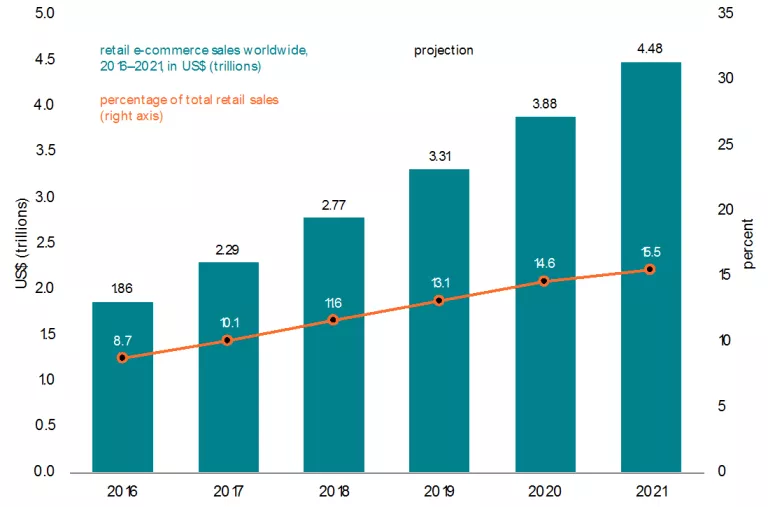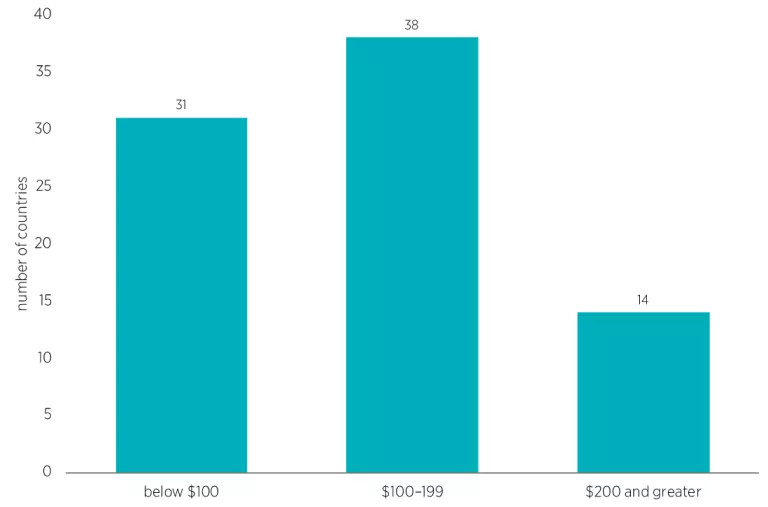- | International Freedom and Trade International Freedom and Trade
- | Federal Testimonies Federal Testimonies
- |
The De Minimis Provision in USMCA: Factors to Consider When Assessing the Potential Economic Effects on the US Economy
Testimony before the US International Trade Commission
The term de minimis is Latin for “about minimal things.” Traditionally, imports of low-value items have been considered too trivial to merit customs consideration. Goods coming across the border valued below the de minimis threshold (DMT) are typically charged no duties and are subjected to minimal clearance procedures and data requirements. Shipments valued above the threshold can be subject to duties, taxes, time-consuming clearance procedures, and burdensome regulations.
As cross-border e-commerce activity has increased in recent years (see figure 1), so too have parcel deliveries. Consequently, the DMT has taken on increased importance in international trade. Time-consuming and burdensome clearance procedures for low-value parcels can be costly for governments, consumers, and businesses, especially small and medium-sized businesses.
There is no estimate of an official optimal DMT, although the International Chamber of Commerce (ICC) recommends establishing a global baseline DMT value of at least $200—and ideally $1,000—in order to “generate economic benefits by refocusing public revenue collection on more efficient revenue sources.” Setting a meaningful DMT will have a positive effect on small and medium-sized enterprises (SMEs) and offer opportunities for increased e-commerce. These guidelines are only a suggestion, however, and countries are free to set their own thresholds. A small number of countries meet the ICC’s recommendation of a DMT of at least $200 (see figure 2). The US DMT is one of the highest in the world at $800.
In the United States-Mexico-Canada Agreement (USMCA), Mexico agreed to a DMT of US$50 for tax-free treatment, and US$117 for tariff-free and streamlined customs treatment (an increase from its current DMT of US$50). Canada agreed to increase its DMT from C$20 to C$150 for duty-free, streamlined customs treatment, and to C$40 for tax-free treatment. These limits apply to packages going through regular mail.
FIGURE 1. RETAIL E-COMMERCE SALES WORLDWIDE, AND SHARE OF TOTAL RETAIL SALES, 2016–2021

Note: Estimates include products or services ordered using the internet, but exclude travel and event tickets. The shaded area indicates projected values and percentages.
Source: Corey McNair, Worldwide Retail and Ecommerce Sales: eMarketer’s Estimates for 2016–2021 (New York: eMarketer, 2017).
Article 7.8.2 in USMCA provides for “fewer customs formalities than those applied under formal procedures” for express shipments valued at less than $2500.[1] Therefore the potential economic effects on the United States of the higher DMT in Canada and Mexico would pertain primarily to shipments sent by standard mail (as opposed to express courier, e.g., FedEx), and specifically shipments sent by standard mail by US businesses to Canada and Mexico. Clarification of this point with the relevant customs and trade agencies would be useful for any corresponding analysis.
FIGURE 2. DMT VALUES BY NUMBER OF COUNTRIES, US$ 2016

Note: The figure includes the DMTs for the 84 countries reported in 2016 USD$, excluding Australia, which eliminated its DMT as of July 1, 2018.
Source: Overview of De Minimis Value Regimes Open to Express Shipments World Wide (Geneva, Switzerland: Global Express Association, 2016).
ECONOMIC EFFECTS OF A HIGHER DMT
In principle, a higher DMT should reduce trade costs for low-value parcels. There is little empirical work on the economic effects of higher DMTs, largely owing to a lack of data.
A recent paper by Consumer Unity & Trust Society (CUTS) International found that increasing the DMT can increase trade potential for micro and small enterprises through lower trade costs.[2] The magnitude of the estimated trade effect depends on whether the DMT increases for the customs duty side or the value-added tax (VAT) side. They found that a US$1 increase in the customs duty DMT is associated with an increase of roughly US$5 million, on average, for micro and small enterprises exports; and increasing the VAT DMT threshold by the same amount is associated with an increase of over US$115 million for micro and small enterprises exports.
Work by Olim Latipov, Christine McDaniel, and Simon Schropp is helpful in understanding the mechanics of the economic effects for a country raising its DMT.[3] They examined the direct economic effects of a higher DMT in Canada for the Canadian government, businesses, and consumers. The authors developed an analytical framework that allows for the simultaneous assessment of DMT policy changes; the model compares the actual (the situation with the current DMT of $20) with a series of counterfactuals (but-for situations in which the DMT is increased to higher levels of $80, $100, or $200). As the economy moves from the actual scenario to the counterfactual scenarios with higher DMTs, the model calculates the changes to government revenues, changes to consumer costs, and changes to business costs.
A higher DMT would free up government resources; however, the magnitude of government savings depends on how the government uses or redirects those savings. The authors consider two options—in one option, the government redirects freed-up resources that were expended on low-value parcels to higher-value parcels. Subsequently, the assessment rate on higher-value parcels increases. That is, the government forgoes taxes and duties on de minimis consignments but gains additional taxes and duties on higher-value parcels. The net budget effect depends on the distribution of parcels across consignment value, among other factors.
In the other option, the government simply pockets the savings, and the assessment rate on higher-value parcels does not change. That is, the government realizes the cost savings internally. The net government savings are greater in this option because assessment cost savings on de minimis parcels outweigh any duty or tax revenue collected on higher-value parcels. The consumer and business savings are also greater in this option since they do not face higher assessment rates on their higher-value parcels.
Consumers and businesses realize cost savings from no longer paying duties, taxes, and brokerage fees, and no longer enduring time-consuming import assessment procedures for low-value parcels (i.e., those above $20 and under the new DMT). Consumers and businesses benefit from a higher DMT in both options (regardless of how the government realizes the savings); however, the savings are greater when the government internalizes the savings instead of redirecting the freed-up resources to higher-value parcel assessments.
Higher DMTs should help smaller firms more than large firms, since smaller firms tend to have fewer resources to expend on administrative tasks, are more likely to ship in small batches, and face a disproportionately high cost of compliance with import procedures.[4]
POTENTIAL ECONOMIC EFFECTS FOR THE US ECONOMY
For the United States, a higher DMT in Canada and Mexico, all else equal, would result in lower costs for US businesses that send low-value parcels to Canada and Mexico, and lower costs for US consumers that buy from Canadian and Mexican businesses and send the merchandise back as a return to the seller. The lower costs result from reductions in taxes, duties, administrative costs, and shipping delays. For instance, in Canada, the tax rate is 11 to 12 percent, duties for parcels under C$200 are 1 to 2 percent, administrative costs can vary, and the average time delay is 3.7 days.[5]
Given the lack of official data on the volume of de minimis postal shipments, the breakdown of standard mail and express mail, and the commercial portion of those shipments, however, it is difficult to determine the volume of trade directly affected by a higher DMT and the corresponding lower trade costs.
Notwithstanding, using data reported by Latipov and coauthors may be helpful in obtaining a rough calculation of the volume of low-value parcels shipped by US firms to Canada. Using those data, an approximate volume of commercial parcels sent by post from the United States to Canada affected by the higher DMT would be 5.3 million to 18.5 million parcels.[6]
Another approach is to start with the US SMEs in manufacturing, retail, and wholesale (sectors that ship tangible items), consider the share of those firms that export to Mexico or Canada (or both), and apply the cost savings accordingly. While the nationwide share of US SMEs that export tends to be low, recent analysis using firm-level data shows that SMEs that use digital platforms or financial technologies in the cross-border e-commerce environment have a higher propensity to export. This matters because the digital platform environments that facilitate business-to-business and business-to-consumer interactions are more likely to involve smaller consignments and hence be affected by the DMT.
For instance, Andreas Lendle and coauthors found that 97 percent of US-based eBay sellers export.[7] In addition, PayPal Public Policy Lab reported that 79 percent of US small businesses on PayPal sell to foreign markets.[8]
In conclusion, there is little empirical work on the economic effects of a higher DMT. On the one hand, the analysis is a straightforward task in that one simply estimates the change in trade cost in an ad valorem–equivalent manner, and then applies it to the relevant trade flows. On the other hand, there is little data on the actual decline in costs and the share of trade affected. Emerging analysis suggests that the higher DMT in USMCA could be particularly important for US SMEs that engage in cross-border e-commerce with Mexico and Canada. A higher DMT may simply reduce costs for current trade, but it may also result in more US firms, particularly SMEs, engaging in international trade, at least with Canada and Mexico. All of these factors should be considered when analyzing the potential economic effects of a higher DMT in the context of USMCA.
[1] See Office of the US Trade Representative, United States-Mexico-Canada Agreement Text, November 30, 2018, https://ustr.gov/sites/default/files/files/agreements/FTA/USMCA/07%20Cu…, chapter 7, article 7.8.2.
[2] “What Does It Cost to Trade Cross-Border: How Higher De Minimis Increases Trade Potential for Micro & Small Enterprises through Lower Costs” (Briefing Paper, CUTS International, Jaipur, India, October 2018).
[3] Olim Latipov, Christine McDaniel, and Simon Schropp, “The De Minimis Threshold in International Trade: The Costs of Being Too Low,” World Economy 41, no. 1 (2018): 337–56.
[4] For instance, regulatory costs per employee have been found to be at least 36 percent higher in small firms than in medium and large firms. See Nicole V. Crain and W. Mark Crain, The Impact of Regulatory Costs on Small Firms (Washington, DC: US Small Business Administration, 2010).
[5] For a complete description and benchmarking of these costs, see Olim Lapitov, Christine McDaniel, and Simon Schropp, “Modeling the Economic Effects of Raising the De Minimis Threshold in Canada” (Essential Policy Intelligence: Technical Paper, C.D. Howe Institute, Toronto, June 23, 2016).
[6] According to data from Canada Post annual reports and calculations by Latipov, McDaniel, and Schropp, “Modeling the Economic Effects,” there are an estimated 37 million inbound post parcels coming into Canada with value. Ten to 50 percent of those 37 million inbound parcels are commercial; see Patrizia Corbi, Estimates of Cross-Border Shopping, 2006 to 2012 (Ottawa: Statistics Canada, October 8, 2014). Suppose all of the 37 mil inbound parcels coming into Canada were from the United States; then 10 to 50 percent of the 37 mil parcels, or 5.3 mil to 18.5 mil parcels, would be directly affected by the higher DMT. Alternatively, suppose half of the 37 mil inbound parcels coming into Canada were from the United States; then 10 to 50 percent of the 18.5 mil parcels, or 1.85 to 9.25 mil parcels, would be directly affected by the higher DMT.
[7] Andreas Lendle, Marcelo Olarreaga, Simon Schropp, and Pierre-Louis Vézina, “eBay’s Anatomy,” Economics Letters 121, no. 1 (2013): 115–20.
[8] Democratizing Globalization: How Small Businesses across America Are Growing in the Digital Marketplace (San Jose, CA: PayPal Government Relations).


